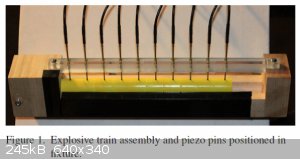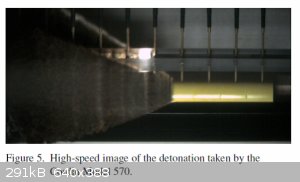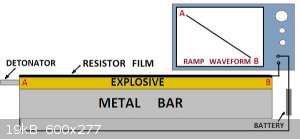
PHILOU Zrealone - 17-7-2015 at 06:20
When looking after slow motion camera, I found the following beast:
Phantom v2511 Camera
This could be used to analyse detonic processes in "slow motion" as it can go up to 1.000.000 frames per seconds...
It is of course out of budget reach for most of us  .
.
If we take the VOD of 10 km/s as a typical example...this camera could take a picture for every centimeter of detonated explosive of a linear
charge...If the detonation is slower then the frame can go above 1 picture/cm of detonating stuff.
The camera must be protected behind a shield.
Praxichys - 17-7-2015 at 08:06
That would be cool but if you look deeper into the tech specs, you can only shoot 1M fps at a resolution of 128x16. I don't know if you'd be able to
see much else other than VoD.
The V711 can do 1.4M fps but only at 128x8.
Where I work, we have a fleet of Phantom Miro M cameras for capturing airbag deployments. At 64x8, they can do 640k fps but that resolution is
basically useless. We usually record at >5000 fps, since a typical curtain deployment takes anywhere from 18 to 35ms.
A LOT of light is needed to get this stuff on film, so we have whole electric panels just for lights. Some of these panels are 45kW, and they run
banks of incandescent bulbs. Lately we have been switching to LED lighting which is much more efficient.
Dany - 17-7-2015 at 10:28
A high speed camera of 2.5 million frames/second will be suitable for recording a detonating explosive charge. This what Army Research Laboratory
(ARL) did. ARL scientists photographed a detonating explosive column boosted with PBXN-5 (95/5 HMX/Viton, also known as LX-10-0). From these rate
sticks they were able to obtain detonation velocity in two way: one from the high speed photography and the other from the piezo pins (see Figure. 1)
embedded in the rate stick at precise location. The detonation velocity obtained by the two method agree with one another within 2%.
Figure 1 (taken from [1]):

"A Cordin Model 570 digital high-speed rotating-mirror framing camera was used to image the detonation event Capable of up to 2.5 million frames/s
recording speed, the Model 570 captures 74 independent frames at 4 Mpixels (2000 x 2000 pixels) resolution with dependent exposure times " see
Figure. 5 (taken also from [1]):

In a nuclear detonation event, high speed cameras have been used to capture the expansion of hot fireball. On such camera is the Rapatronic.
A nice video of a nuclear fireball expansion captured by Rapatronic camera (Rapatronic camera can take 50 million frames/second):
http://www.youtube.com/watch?v=KQp1ox-SdRI
References:
[1] Matthew M. Biss and Kimberly Y. Spangler, Detonation Velocity Measurements from a Digital High-speed Rotating-mirror Framing Camera, Army Research
Laboratory, ARL-TN-0502, 2012.
Dany.
Attachment: ARL.pdf (603kB)
This file has been downloaded 606 times
nitro-genes - 17-7-2015 at 15:56
In case of a nuclear event, at least you don't need external lighting. 
Speaking of light...sort of off topic, though very interesting talk:
https://www.ted.com/talks/ramesh_raskar_a_camera_that_takes_...
franklyn - 20-7-2015 at 22:55
http://www.youtube.com/v/3L91F9o600E
http://www.advancedscientificconcepts.com
Alternative approach
Assuming 10,000 meters per second detonation rate , a 20 centimeter test sample of explosive is gone in 0.00002 seconds. A low cost digital storage
oscilloscope attachment for a laptop computer with a 20 megahertz bandwidth and 0.000001 second per division timebase , having a sampling rate of ~
50 Megasamples per second or better , is more than adequate to chart the detonation. See examples below
In the scheme depicted , a measured length of explosive is sandwiched between a sturdy metal base laid on masonry , and a strip of paper in contact
with the layer of explosive which has been rubbed with a soft lead pencil ( No. 2 or a drafting B type ) to surface it with a uniform layer of
graphite that appears like shiny gray metal. The explosive should be in direct contact with the penciled surface side on the paper without other
intervening material. Upon initiation , the electrically conductive detonation front bridges the two materials in contact with the explosive
completing an electric circuit. This detonation wave traveling from point ' A ' to point ' B ' reduces the conductive path of the graphite resistor
the same as a tunable rotary pot variable resistor.
Measuring the resistance of the prepared paper resistor strip using an Ohmmeter one can obtain a baseline reading to compare and obtain a tunable
rotary pot variable resistor to substitute in the test setup layout in order to calibrate the oscilloscope. It should be set to trigger recording a
trace at the lowest available setting. Whether the screen trace will ramp up or down is a matter of choice since one can arbitrarily switch the signal
so that it is inverted even post detonation working from the stored data and image of the trace. Dividing the length of the detonated sample by the
horizontal time measurement directly tells you the velocity of detonation.
It is very important that the connection made to the metal busbar is at the opposite end to the connection with the resistor film , otherwise with
both connections at the same end of the setup , the circuit loop will become smaller as detonation proceeds , augmenting the whole circuit induction
which creates a surge of current. The battery in series provides the essential power and reference for measurement.
http://www.ebay.com/itm/DDS120-Pro-20MHz-PC-Based-USB-Digita...
http://www.ebay.com/itm/SainSmart-DDS120-Pro-20MHz-PC-Based-...
http://www.ebay.com/itm/AGPTEK-Pro-20MHz-PC-Based-USB-Digita...
http://www.ebay.com/itm/Hantek-6022BE-PC-Based-USB-Digital-S...
.


 .
.